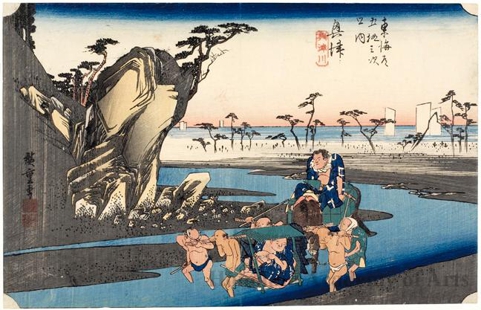
Title : The Okitsu River at Okitsu (Station # 18)
Artist : Utagawa Hiroshige
Date : c. 1833 - 1834
Details : More information...
Source :
Honolulu Museum of Art
Browse all 5471 prints...
Description : In this print, note the single-layered indigo-blue summer wear with large repetitious patterns typical of katazome, stencil-dyed fabrics. Katazome, a traditional rice-paste resist technique, has been practiced in Japan since at least the sixteenth century. Rice paste is applied to fabric through a paper stencil cut in specific designs, after which the cloth is dipped in an indigo dye bath. The paste prevents dye from penetrating the design areas, thus creating bold white patterns against an indigo-blue ground. A style of katazome that used large patterns, or chugata (medium sized stencil), was developed during the Edo period and frequently used to decorate commoners' cotton clothing. A detail of Hiroshige's delightful river-crossing scene features two huge sumo wrestlers clad in indigo summer yukata decorated with bold white katazome patterns of different design. Four nearly naked palanquin bearers, rather than the usual two, struggle to carry one of the wrestlers in a too-small palanquin, while the other wrestler rides a horse. The horse is led by a groom dressed in a hanten, a short-sleeved open jacket, on which is stenciled in several places the character su, the first character of sumo. There is subtle humor in Hiroshige's depiction of the enormous wrestlers traveling on a hot summer day, their round bellies spilling out of loosened yukata, while an indigo-blue river runs coolly beneath them. (from “Blue and White” textiles exhibition 8/28/2008-)
Download ImageDo you have a similar woodblock print to sell?
Get in touch with us for a preliminary estimate and for information in selling your woodblock print.
GET IN TOUCH